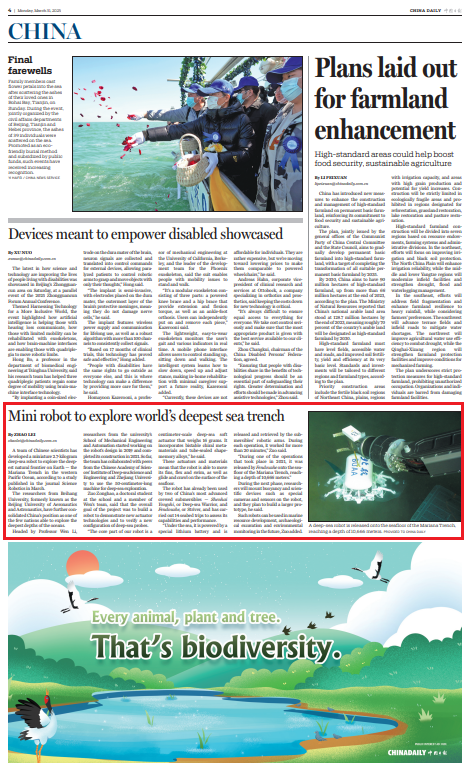《CHINA DAILY》2025年3月28日(ZHAO LEI)报道:
Deep-sea robot proof of nation's scientific prowess

Chinese scientists have achieved a number of scientific, technological and engineering breakthroughs in the field of deep-sea exploration over the past years, ushering China into an elite club of nations that are able to probe the ocean's depths.
Now, a group of researchers at Beihang University, formerly known as the Beijing University of Aeronautics and Astronautics, have further consolidated China's lead in this arena by creating a miniature deep-sea robot and deploying it to explore the Mariana Trench in the western Pacific Ocean, the deepest natural frontier on Earth.

Headed by Professor Wen Li, researchers from the university's School of Mechanical Engineering and Automation started the robot's design work in 2019 and completed its construction in 2021. Subsequently, they began to work with peers from the Chinese Academy of Sciences' Institute of Deep-sea Science and Engineering and Zhejiang University to use the 2.7-kilogram machine for deep-sea exploration.
Zuo Zonghao, a doctoral student at the school and member of Wen's team, said that the overall goal of this project is to build a robot to demonstrate new actuator technologies and to verify a new configuration of deep-sea probes.
"The core part of our robot is a centimeter-scale deep-sea soft actuator that weighs 16 grams. It incorporates bistable chiral metamaterials and tube-sealed shape-memory alloys," he said.
Thanks to the cutting-edge actuator, the untethered robot is capable of making various types of movements, such as swimming, gliding and crawling, by coordinating its legs and fins, according to the researcher.
The robot has already ridden with two of China's most advanced crewed submersibles — Shenhai Yongshi, or Deep-Sea Warrior, and Fendouzhe, or Striver — and has carried out 14 seabed trips to check its capability and performance.
"Under the sea, it is powered by a special lithium battery and is released and retrieved by the submersible's robotic arms. During each operation, it worked for more than 20 minutes," Zuo said. "During one of the operations that took place in 2021, it was released by the Fendouzhe onto the sea floor of the Mariana Trench, reaching a depth of 10,600 meters."
In the next phase, researchers will mount buoyancy devices and some scientific payloads such as special cameras and sensors on the robot, and plan to make a larger prototype, he said.
Such robots can be used in marine resource development, archaeological excavation and environmental monitoring in the future, Zuo added.
媒体链接:https://enapp.chinadaily.com.cn/a/202503/28/AP67e6acb8a310e35e1ad250f9.html
编辑:贾爱平